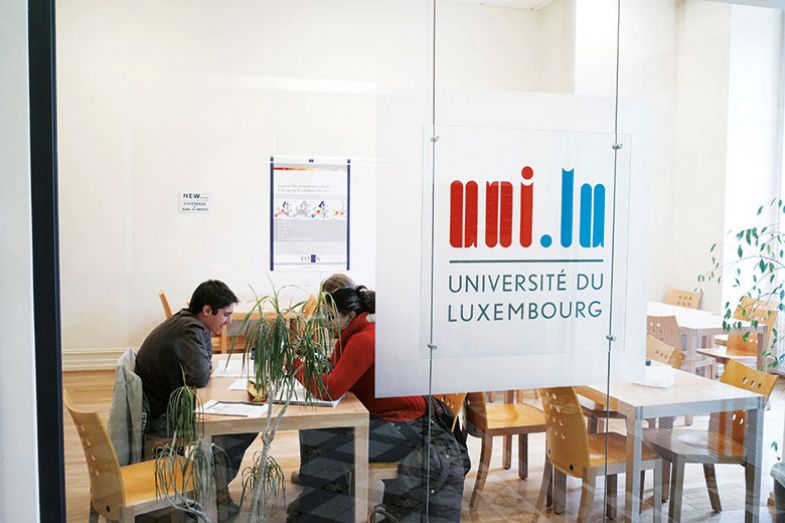Browse the full results of the World University Rankings 2020
New entrants have shaken up the international outlook pillar of the Times Higher Education World University Rankings this year, with universities in cosmopolitan hubs such as Switzerland and Hong Kong coming out on top.
Internationalisation is vital for preparing students for a globalised world and for undertaking research that can have an impact and improve livelihoods, say the pillar-leading institutions.
THE determines the top universities in this pillar based on their proportion of international students and staff, as well as their share of international research collaborations. The seeds of success are similar for most highly ranked universities.
The University of Luxembourg is the top-performing institution, up from joint third place last year. The university is a multilingual institution, with programmes taught in a variety of languages including English, French and German. Its academic staff hail from about 20 different countries, while its 6,300 students come from across 110 nations.

“Providing a research and teaching environment with a distinctly international character is one of the defining ambitions of the University of Luxembourg – it is a core strand of its DNA,” says Stéphane Pallage, the institution’s rector.
“Our university promotes a culture of great openness in terms of transnational collaboration on its research projects. We try to attract the best and the brightest, independently of nationality, to support the research and teaching priorities of the university and its interdisciplinary centres.”
Four universities share second place: City University of Hong Kong, Macau University of Science and Technology, Qatar University and Università della Svizzera Italiana in Switzerland.
Hong Kong is one of the heavyweight performers in this year’s pillar, with all six of its ranked institutions featuring in the top 50. Alongside City University of Hong Kong, four other universities make the top 20.

“Hong Kong is an international hub – truly a mix of East and West – and we’re an attractive location for people of multiple backgrounds,” says Sabrina Lin, vice-president for institutional advancement at Hong Kong University of Science and Technology (HKUST).
The institution, which comes 14th for international outlook, opened its doors in 1991, when the territory was still a British colony, and it has been cosmopolitan since its inception. “We have a history of recruiting internationally,” Lin says.
Of its more than 680 faculty members, just under half are from countries outside mainland China, ranging from Australia to Tunisia. And this international faculty environment breeds cross-border collaboration, Lin explains. The international staff have existing partnerships and networks from their previous institutions, and “we take advantage of that”, she says.
Last year, Hong Kong Baptist University (HKBU), which is ranked joint 15th in the international pillar, introduced the “Talent100” initiative, aiming to recruit 100 new academic staff from around the world by the end of 2022.
“We have already brought more than 50 of these academics on board, with many others on the way,” says Roland Chin, HKBU’s president. “[The initiative] is designed to build the university’s academic capacity and to bring in new ideas and approaches that can help us transform into a regional leader with a purposeful international presence.”

Università della Svizzera Italiana (USI), which makes its debut in the World University Rankings this year, also focuses on attracting international staff. The Swiss institution has academic staff from 58 countries and students from more than 100 nations.
“USI was created with the explicit aim of attracting students from beyond the region in which it is located,” says Boas Erez, the university’s rector. “Internationalisation is an essential part of the development strategy of our university, which is underscored by the number of our foreign students.”
The institution has established more than 100 exchange agreements with institutions around the world, which allow its students to experience other universities and countries.
Institutions at the top of the international outlook pillar are in agreement that having a high proportion of international students and staff pays dividends.
“The benefits of internationalisation for both domestic and foreign students are enormous,” says HKBU’s Chin. “Understanding different cultures and places is essential for the graduate of the 21st century.”
It is also necessary from a research perspective. “International connections can serve as catalysts and platforms enabling universities such as ours to imagine new solutions for big questions, and allowing us to respond meaningfully to complex global challenges,” he adds.
This sentiment is echoed by HKUST’s Lin.
“The employers in the region are all from different backgrounds. It is important for us to offer experiences to our students so that they can be prepared to work with people from different backgrounds,” she says.
Her institution also offers dual degrees to allow students to get a taste of life in another country and to study subjects that are not available at the Hong Kong campus. For example, HKUST has partnered with the University of Exeter in the UK to offer students the opportunity to enrol in an engineering degree with a graduate qualification in law.
“We don’t have a law school,” Lin says, “so we partner with the University of Exeter for law.”
Another way of offering students international experience is through exchange programmes.
The University of Auckland, which is ranked joint 49th for international outlook, aims to increase student mobility through access to scholarships and bursaries. Currently, international students account for almost a third of the student cohort, and about 38 per cent of academic staff come from another country. Like many other locations that rank well in the international pillar, Auckland is a cosmopolitan city.
“The international and diverse nature of the city in which we are located is reflected in our university,” says Lisa Finucane, the institution’s media and communications manager. In fact, almost half of Auckland’s workforce was born outside New Zealand, she says.
The university has set itself a target of ensuring that by 2020 one in four graduating students will have had a learning experience abroad during their degree. Auckland also has a travel grant programme to help professional and academic staff attend networking events and to support them in assessing collaboration opportunities, she says. Grants are valued at up to NZ$8,000 (£4,300), and more than NZ$100,000 is allocated annually to support staff engagement in international networks.
At Luxembourg, all undergraduates must spend a semester abroad. The university also allows joint supervision for master’s and doctoral candidates, enabling them to also have a supervisor in another country.
Similarly, HKBU operates a large exchange programme. “We have some 400 exchange partner universities around the world, and overseas exchange students are joining us in growing numbers for one or two semesters of their studies,” Chin says. At the same time, the number of foreign students enrolling at the university for full undergraduate studies has more than tripled since 2016.
A major reason for international engagement is to make it possible for universities to benchmark their research output and student achievements to international standards.
“We don’t want to say we have the best students in Hong Kong,” Lin says. “We have to prepare our students to be among the best in the world. We want to benchmark ourselves and get other people to give us critical input.”
International outlook pillar
|
Rank in pillar |
Position in World University Rankings |
Institution |
Country/region |
Pillar score |
|
1 |
201–250 |
Luxembourg |
99.7 |
|
|
=2 |
126 |
Hong Kong |
99.6 |
|
|
=2 |
251–300 |
Macao |
99.6 |
|
|
=2 |
401–500 |
Qatar |
99.6 |
|
|
=2 |
301–350 |
Università della Svizzera Italiana |
Switzerland |
99.6 |
|
6 |
601–800 |
United Arab Emirates |
99.1 |
|
|
=7 |
=38 |
Switzerland |
98.6 |
|
|
=7 |
35 |
Hong Kong |
98.6 |
|
|
9 |
301–350 |
Macao |
98.5 |
|
|
10 |
=144 |
Switzerland |
98.4 |
|
|
11 |
=13 |
Switzerland |
98.2 |
|
|
12 |
251–300 |
Saudi Arabia |
98.1 |
|
|
13 |
=57 |
Chinese University of Hong Kong |
Hong Kong |
97.8 |
|
14 |
47 |
Hong Kong |
97.7 |
|
|
=15 |
401–500 |
Hong Kong |
97.6 |
|
|
=15 |
127 |
Netherlands |
97.6 |
|
|
17 |
401–500 |
Austria |
97.4 |
|
|
18 |
10 |
United Kingdom |
97.1 |
|
|
19 |
=110 |
United Kingdom |
96.7 |
|
|
20 |
=198 |
United Kingdom |
96.6 |
|
|
21 |
251–300 |
United Kingdom |
96.5 |
|
|
=22 |
1 |
United Kingdom |
96.4 |
|
|
=22 |
201–250 |
United Kingdom |
96.4 |
|
|
24 |
15 |
UCL |
United Kingdom |
96.2 |
|
=25 |
=94 |
Switzerland |
96.1 |
|
|
=25 |
=194 |
Australia |
96.1 |
|
|
27 |
251–300 |
New Zealand |
95.8 |
|
|
=28 |
=168 |
United Kingdom |
95.7 |
|
|
=28 |
401–500 |
Switzerland |
95.7 |
|
|
30 |
=36 |
United Kingdom |
95.6 |
|
|
=31 |
50 |
Australia |
95.5 |
|
|
=31 |
25 |
Singapore |
95.5 |
|
|
33 |
351–400 |
United Arab Emirates |
95.4 |
|
|
34 |
351–400 |
Brunel University London |
United Kingdom |
95.3 |
|
35 |
93 |
École Polytechnique |
France |
95.2 |
|
36 |
=48 |
Singapore |
95.1 |
|
|
37 |
3 |
United Kingdom |
95.0 |
|
|
38 |
401–500 |
United Kingdom |
94.9 |
|
|
39 |
801–1,000 |
United Arab Emirates |
94.8 |
|
|
=40 |
34 |
Canada |
94.4 |
|
|
=40 |
164 |
Republic of Ireland |
94.4 |
|
|
42 |
=131 |
University of Western Australia |
Australia |
94.3 |
|
=43 |
251–300 |
Australia |
94.2 |
|
|
=43 |
=139 |
United Kingdom |
94.2 |
|
|
=43 |
501–600 |
New Zealand |
94.2 |
|
|
=43 |
122 |
United Kingdom |
94.2 |
|
|
=43 |
=134 |
Austria |
94.2 |
|
|
48 |
171 |
Hong Kong Polytechnic University |
Hong Kong |
94.1 |
|
=49 |
=179 |
New Zealand |
94.0 |
|
|
=49 |
251–300 |
United Kingdom |
94.0 |
Register to continue
Why register?
- Registration is free and only takes a moment
- Once registered, you can read 3 articles a month
- Sign up for our newsletter
Subscribe
Or subscribe for unlimited access to:
- Unlimited access to news, views, insights & reviews
- Digital editions
- Digital access to THE’s university and college rankings analysis
Already registered or a current subscriber?








